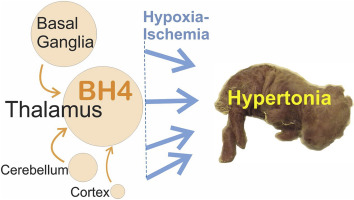Redox Biology ( IF 11.4 ) Pub Date : 2019-12-12 , DOI: 10.1016/j.redox.2019.101407 Jeannette Vasquez-Vivar 1 , Zhongjie Shi 2 , Jeong-Won Jeong 3 , Kehuan Luo 2 , Amit Sharma 4 , Karthikeyan Thirugnanam 1 , Sidhartha Tan 5

|
Hypertonia is pathognomonic of cerebral palsy (CP), often caused by brain injury before birth. To understand the early driving events of hypertonia, we utilized magnetic resonance imaging (MRI) assessment of early critical brain injury in rabbit fetuses (79% term) that will predict hypertonia after birth following antenatal hypoxia-ischemia. We examined if individual variations in the tetrahydrobiopterin cofactor in the parts of the brain controlling motor function could indicate a role in specific damage to motor regions and disruption of circuit integration as an underlying mechanism for acquiring motor disorders, which has not been considered before. The rabbit model mimicked acute placental insufficiency and used uterine ischemia at a premature gestation. MRI during the time of hypoxia-ischemia was used to differentiate which individual fetal brains would become hypertonic. Four brain regions collected immediately after hypoxia-ischemia or 48 h later were analyzed in a blinded fashion. Age-matched sham-operated animals were used as controls. Changes in the reactive nitrogen species and gene expression of the tetrahydrobiopterin biosynthetic enzymes in brain regions were also studied. We found that a combination of low tetrahydrobiopterin content in the cortex, basal ganglia, cerebellum, and thalamus brain regions, but not a unique low threshold of tetrahydrobiopterin, contributed etiologically to hypertonia. The biggest contribution was from the thalamus. Evidence for increased reactive nitrogen species was found in the cortex. By 48 h, tetrahydrobiopterin and gene expression levels in the different parts of the brain were not different between MRI stratified hypertonia and non-hypertonia groups. Sepiapterin treatment given to pregnant dams immediately after hypoxia-ischemia ameliorated hypertonia and death. We conclude that a developmental tetrahydrobiopterin variation is necessary with fetal hypoxia-ischemia and is critical for disrupting normal motor circuits that develop into hypertonia. The possible mechanistic pathway involves reactive nitrogen species.
中文翻译:

胎儿缺氧-复氧损伤和运动缺陷发展的神经元脆弱性取决于区域脑四氢生物蝶呤水平。
高渗是脑性瘫痪(CP)的病理表现,通常由出生前的脑损伤引起。为了了解高渗的早期驾驶事件,我们利用磁共振成像(MRI)评估了兔胎儿(79%足月)的早期严重脑损伤,它将在产前缺氧缺血后预测出生后的高渗。我们检查了四氢生物蝶呤辅助因子在控制运动功能的大脑各部分中的个体差异是否可以表明在运动区域的特定损伤和电路整合的破坏中,这是获得运动障碍的潜在机制,这一点以前从未考虑过。兔子模型模仿了急性胎盘功能不全,并在早孕时使用了子宫缺血。缺氧缺血时的MRI用于区分哪些胎儿大脑会变得高渗。缺氧缺血后或48小时后立即收集的四个大脑区域以盲法分析。年龄匹配的假手术动物用作对照。还研究了大脑区域四氢生物蝶呤生物合成酶的活性氮种类和基因表达的变化。我们发现,皮层,基底神经节,小脑和丘脑脑区域中四氢生物蝶呤含量低,但并不是四氢生物蝶呤的独特低阈值,在病因上有助于高渗。丘脑是最大的贡献。在皮层中发现了增加的活性氮物质的证据。到48小时,MRI分层高渗组和非高渗组之间四氢生物蝶呤和大脑不同部位的基因表达水平没有差异。缺氧缺血后立即对怀孕的大坝进行Sepaapterin治疗可减轻高渗和死亡。我们得出结论,胎儿缺氧缺血发展四氢生物蝶呤变化是必要的,并且对于破坏发展为高渗的正常运动回路至关重要。可能的机理途径涉及反应性氮物种。我们得出结论,胎儿缺氧缺血发展四氢生物蝶呤变化是必要的,并且对于破坏发展为高渗的正常运动回路至关重要。可能的机理途径涉及反应性氮物种。我们得出结论,胎儿缺氧缺血发展四氢生物蝶呤变化是必要的,并且对于破坏发展为高渗的正常运动回路至关重要。可能的机理途径涉及反应性氮物种。


























 京公网安备 11010802027423号
京公网安备 11010802027423号